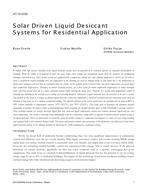-
-
Available Formats
- Options
- Availability
- Priced From ( in USD )
-
Available Formats
-
- Immediate download
-
$16.00Members pay $7.00
- Add to Cart
Customers Who Bought This Also Bought
-

AT-15-C030 -- Developing and Modeling Potential Precoolin...
Priced From $16.00 -

AT-15-C059 -- Climate Chamber Tests for Measuring Perform...
Priced From $16.00 -

AT-15-C035 -- A Study of Refrigerant Dispersion in Occupi...
Priced From $16.00 -

AT-15-C048 -- Outside Air, Economizers, and Exhaust Air E...
Priced From $16.00
About This Item
Full Description
In regions with high summer humidity levels, liquid desiccant systems have the potential to be extremely effective as renewable dehumidifiers in buildings. With the ability to be powered by solar hot water tanks, these systems are energetically cleaner than the standard air conditioning techniques currently in use. These current systems are equipped with a compressor, cooling coil, and a flowing refrigerant to cool the air. In order to create a comfortable relative humidity level, the temperature of the incoming air must be dropped below its dew point; this is the temperature at which water condenses and can then be eliminated from the system. In the majority of the United States, dew point temperatures are much lower than comfortable temperatures. Therefore, in current standard practice, air is first cooled far below comfortable temperatures to reduce humidity levels, and then heated back up to a more acceptable climate before entering the living space. However, if a system with independent control of humidity was introduced, the need for excess cooling and reheating would be eliminated. Liquid desiccants have the potential to be such a system. The purpose of this study is to design an efficient liquid desiccant system that implements a small air-to-liquid desiccant interaction device with the intention of long term use in a common residential building. The objective efficiency of the system would lower the humidity level to between 40% to 50% relative humidity at temperatures between 72°F (22.2°C) and 78°F (25.6°C). This study aims to determine the optimum variable magnitudes to produce the highest extent of dehumidification while occupying the smallest possible space to fully dehumidify a common residence. These variables include air velocity, desiccant liquid flow rate, desiccant liquid temperature, contact area between desiccant liquid and air, and water temperature. The system is currently being individually tested in a laboratory setting with an aqueous Calcium Chloride solution acting as the liquid desiccant. There are future plans to install the system for further testing in a community lab designed as a solar, net-zero energy building and equipped with a solar powered thermal tank. This paper will provide valuable data pertaining to the effectiveness and efficiency of solar driven liquid desiccant systems in the common residence by discussing the results conducted in a laboratory setting.





